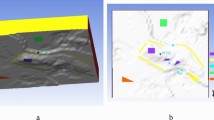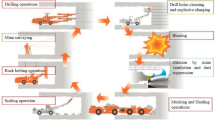Abstract
To understand the concentration and distribution of PM2.5 and PM10 in open-pit mines, a beta-ray particle monitor and some laser monitors were arranged in Haerwusu Surface Coal Mine (HSCM), Inner Mongolia, China. A fluent simulation was made to study the dust move in the pit and escape rate and time out of the pit. The main conclusions include (1) in HSCM, the concentration of PM10 changes with that of PM2.5, meeting the power function PM10 = 2.548 × PM2.50.993. The dust concentration around the working mining equipment is very high. For example, around a working drill, the PM2.5 can be up to 426 μg/m3, and around a working power shovel, the PM2.5 can be up to 352 μg/m3. (2) At the same time, the PM2.5 concentration is nearly equal throughout the pit, away from the operating equipment, with a confidence level of 95%. The mean dust concentration away from the equipment is 76.7 μg/m3 when this mining equipment is working. So, the number of monitors in the pit can be decreased without affecting the quality of dust monitoring, which means that the cost of monitoring can be cut down. (3) Base on Fluent simulation results, the average escape time of dust particles with different diameters is similar, but the maximum escape time decreases as the particle diameter increases, which means that most dust moves with the air swirl, but some smaller dust particles can hang in the pit for a longer time. Also, the escape rate decreases rapidly as the diameter of the dust increases. (4) Dust is rotated and diffused evenly in the pit under the action of the eddy current in the pit. Finally, when the dust is swirled to a higher level than that of the pit head, the dust can escape out of the pit.




















Similar content being viewed by others
References
Abu-Allaban, M., Lowenthal, D. H., Gertler, A. W., & Labib, M. (2007). Sources of PM10 and PM2.5 in Cairo’s ambient air. Environmental Monitoring and Assessment, 133(1–3), 417–425. https://doi.org/10.1007/s10661-006-9596-8.
Amandus, H. E., Petersen, M. R., & Richards, T. B. (1989). Health status of anthracite surface coal miners. Archives of Environmental Health, 44(2), 75–81.
Aurell, J., Gullett, B. K., & Yamamoto, D. (2012). Emissions from open burning of simulated military waste from forward operating bases. Environmental Science & Technology, 46(20), 11004–11012. https://doi.org/10.1021/es303131k.
Bonifacio, H. F., Maghirang, R. G., Trabue, S. L., McConnell, L. L., Prueger, J. H., & Bonifacio, E. R. (2015). TSP, PM10, and PM2.5 emissions from a beef cattle feedlot using the flux-gradient technique. Atmospheric Environment, 101, 49–57. https://doi.org/10.1016/j.atmosenv.2014.11.017.
Evagelopoulos, V., Zoras, S., Triantafyllou, A. G., & Albanis, T. A. (2005). PM10-PM2.5 time series and fractal analysis. In T. D. Lekkas (Ed.), Proceeding of the 9th International Conference on Environmental Science and Technology Vol B - Poster Presentations (pp. B169-B174). Proceedings of the International Conference on Environmental Science and Technology.
Gao, J., Tian, H., Cheng, K., Lu, L., Zheng, M., Wang, S., Hao, J., Wang, K., Hua, S., Zhu, C., & Wang, Y. (2015). The variation of chemical characteristics of PM2.5 and PM10 and formation causes during two haze pollution events in urban Beijing, China. Atmospheric Environment, 107, 1–8. https://doi.org/10.1016/j.atmosenv.2015.02.022.
Hu, J., Wang, Y., Ying, Q., & Zhang, H. (2014). Spatial and temporal variability of PM2.5 and PM10 over the North China Plain and the Yangtze River Delta, China. Atmospheric Environment, 95, 598–609. https://doi.org/10.1016/j.atmosenv.2014.07.019.
Kang, J.-Y., Mikami, M., & Yoon, S.-C. (2013). A numerical study of the effect of frozen soil on dust emission during an East Asian dust event in December 2009. Asia-Pacific Journal of Atmospheric Sciences, 49(1), 57–65.
Kok, J. F. (2015). An improved model for mineral dust emission (invited presentation). Seventh Symposium on Aerosol-Cloud-Climate Interactions.
Kok, J. F., Mahowald, N. M., Albani, S., Fratini, G., Gillies, J. A., Ishizuka, M., Leys, J. F., Mikami, M., Park, M. S., Park, S. U., van Pelt, R. S., Ward, D. S., & Zobeck, T. M. (2014). An improved dust emission model with insights into the global dust cycle’s climate sensitivity. Atmospheric Chemistry and Physics Discussions, 14(5), 6361–6425.
Li, Z., Sjoedin, A., Romanoff, L. C., Horton, K., Fitzgerald, C. L., Eppler, A., et al. (2011). Evaluation of exposure reduction to indoor air pollution in stove intervention projects in Peru by urinary biomonitoring of polycyclic aromatic hydrocarbon metabolites. Environment International, 37(7), 1157–1163. https://doi.org/10.1016/j.envint.2011.03.024.
Lu, H., & Shao, Y. (1999). A new model for dust emission by saltation bombardment. Journal of Geophysical Research-Atmospheres, 104(D14), 16827–16842.
Pless-Mulloli, T., King, A., Howel, D., Stone, I., & Merefield, J. (2000). PM 10 levels in communities close to and away from opencast coal mining sites in Northeast England. Atmospheric Environment, 34(19), 3091–3101.
Romualdo, L. L., Santos, R. S., Lima, F. C., Andrade, L. S., Ferreira, I. M., & Pozza, S. A. (2015). Environmental impact monitoring of a minero-chemical complex in Catalao urban area of PTS, PM10 and PM2.5 by EDX characterization. Icheap12: 12th International Conference on Chemical & Process Engineering, 43, 1909–1914. https://doi.org/10.3303/cet1543319.
Shao, Y. (2001). A model for mineral dust emission. Journal of Geophysical Research-Atmospheres, 106(D17), 20239–20254.
Silvester, S. A., Lowndes, I. S., & Hargreaves, D. M. (2009). A computational study of particulate emissions from an open pit quarry under neutral atmospheric conditions. Atmospheric Environment, 43(40), 6415–6424.
Sosa, G., Vega, E., Gonzálezavalos, E., Mora, V., & Lópezveneroni, D. (2013). Air pollutant characterization in Tula industrial corridor, central Mexico, during the MILAGRO study. BioMed Research International, 2013(10), 521728.
Takeuchi, T. T., & Ishii, T. T. (2004). A dust emission model of Lyman-break galaxies. Astronomy & Astrophysics, 426(2), 425–435.
Tartakovsky, D., Broday, D. M., & Stern, E. (2013). Evaluation of AERMOD and CALPUFF for predicting ambient concentrations of total suspended particulate matter (TSP) emissions from a quarry in complex terrain. Environmental Pollution, 179(8), 138–145.
Titos, G., Lyamani, H., Pandolfi, M., Alastuey, A., & Alados-Arboledas, L. (2014). Identification of fine (PM1) and coarse (PM10-1) sources of particulate matter in an urban environment. Atmospheric Environment, 89, 593–602. https://doi.org/10.1016/j.atmosenv.2014.03.001.
Tiwari, S., Srivastava, A. K., Bisht, D. S., Bano, T., Singh, S., Behura, S., Srivastava, M. K., Chate, D. M., & Padmanabhamurty, B. (2009). Black carbon and chemical characteristics of PM10 and PM2.5 at an urban site of North India. Journal of Atmospheric Chemistry, 62(3), 193–209. https://doi.org/10.1007/s10874-010-9148-z.
Tiwari, S., Hopke, P. K., Pipal, A. S., Srivastava, A. K., Bisht, D. S., Tiwari, S., Singh, A. K., Soni, V. K., & Attri, S. D. (2015). Intra-urban variability of particulate matter (PM2.5 and PM10) and its relationship with optical properties of aerosols over Delhi, India. Atmospheric Research, 166, 223–232. https://doi.org/10.1016/j.atmosres.2015.07.007.
Vaupel, K., Klenk, U., & Schmidt, E. (2016). Emissions from open pit mines - a challenge for air dispersion modeling. Gefahrstoffe Reinhaltung der Luft, 76(1–2), 14–18.
Xing, Z. & Du, K. (2017). Particulate matter emissions over the oil sands regions in Alberta, Canada. Environmental Reviews.
Yokelson, R. J., Burling, I. R., Gilman, J. B., Warneke, C., Stockwell, C. E., de Gouw, J., Akagi, S. K., Urbanski, S. P., Veres, P., Roberts, J. M., Kuster, W. C., Reardon, J., Griffith, D. W. T., Johnson, T. J., Hosseini, S., Miller, J. W., Cocker III, D. R., Jung, H., & Weise, D. R. (2013). Coupling field and laboratory measurements to estimate the emission factors of identified and unidentified trace gases for prescribed fires. Atmospheric Chemistry and Physics, 13(1), 89–116. https://doi.org/10.5194/acp-13-89-2013.
Zhou, X., Zhaoyu, C., Ma, Y., Wang, L., Wu, R., & Wang, W. (2016). Concentrations, correlations and chemical species of PM2.5/PM10 based on published data in China: potential implications for the revised particulate standard. Chemosphere, 144, 518–526.
Acknowledgments
Project is supported by National Key Technology R&D Program (2016YFC0501100) and the National Natural Science Foundation of China (51034005) which is greatly appreciated.
Author information
Authors and Affiliations
Corresponding author
Rights and permissions
About this article
Cite this article
Wanjun, T., Qingxiang, C. Dust distribution in open-pit mines based on monitoring data and fluent simulation. Environ Monit Assess 190, 632 (2018). https://doi.org/10.1007/s10661-018-7004-9
Received:
Accepted:
Published:
DOI: https://doi.org/10.1007/s10661-018-7004-9




